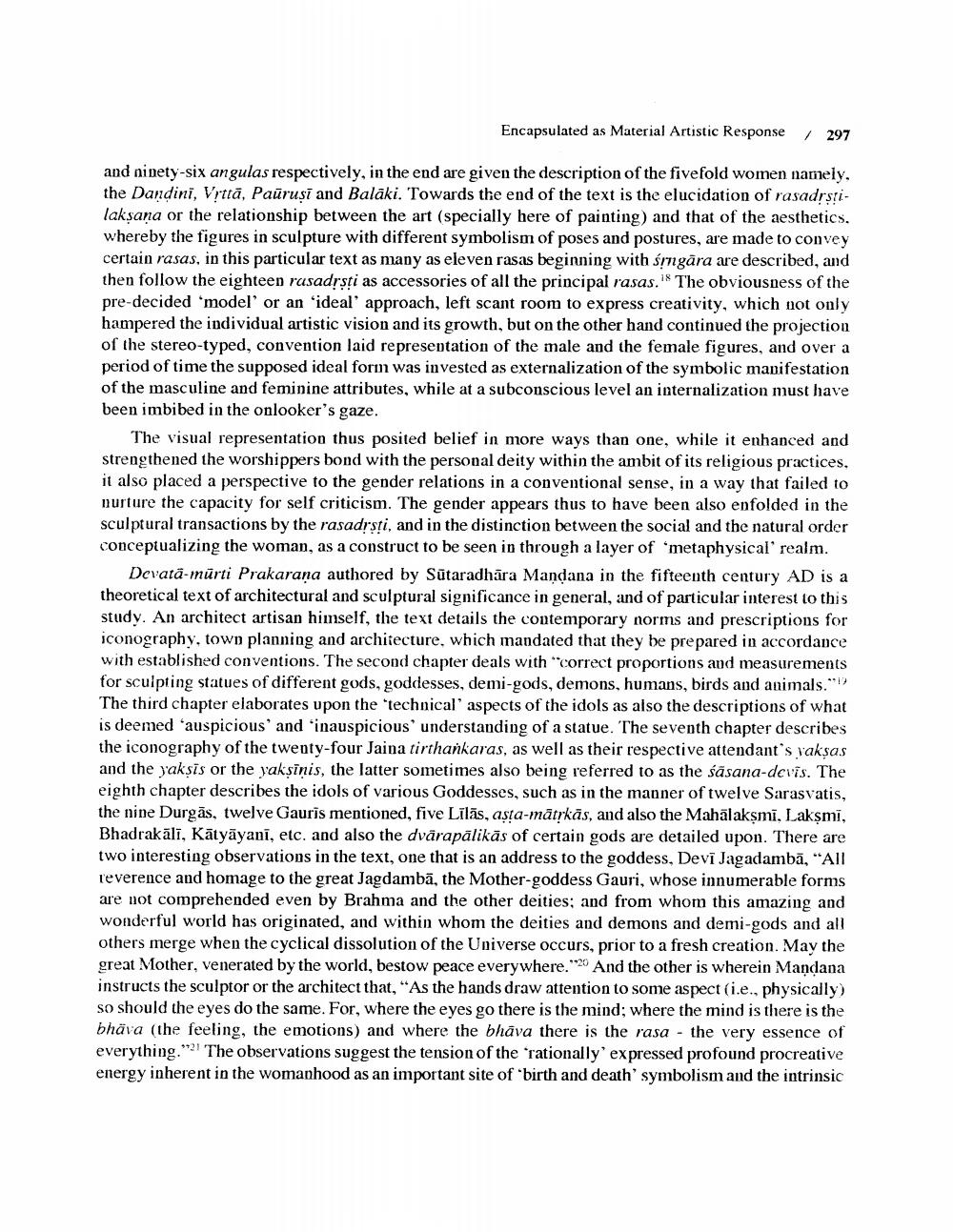________________
Encapsulated as Material Artistic Response / 297
and ninety-six angulas respectively, in the end are given the description of the fivefold women namely, the Dandini, Vṛtta, Paūruṣī and Balāki. Towards the end of the text is the elucidation of rasadṛṣṭilakṣaṇa or the relationship between the art (specially here of painting) and that of the aesthetics. whereby the figures in sculpture with different symbolism of poses and postures, are made to convey certain rasas, in this particular text as many as eleven rasas beginning with singāra are described, and then follow the eighteen rasadṛṣṭi as accessories of all the principal rasas. The obviousness of the pre-decided 'model' or an 'ideal' approach, left scant room to express creativity, which not only hampered the individual artistic vision and its growth, but on the other hand continued the projection of the stereo-typed, convention laid representation of the male and the female figures, and over a period of time the supposed ideal form was invested as externalization of the symbolic manifestation of the masculine and feminine attributes, while at a subconscious level an internalization must have been imbibed in the onlooker's gaze.
The visual representation thus posited belief in more ways than one, while it enhanced and strengthened the worshippers bond with the personal deity within the ambit of its religious practices. it also placed a perspective to the gender relations in a conventional sense, in a way that failed to nurture the capacity for self criticism. The gender appears thus to have been also enfolded in the sculptural transactions by the rasadṛsti, and in the distinction between the social and the natural order conceptualizing the woman, as a construct to be seen in through a layer of metaphysical' realm.
Devata-murti Prakarana authored by Sutaradhara Mandana in the fifteenth century AD is a theoretical text of architectural and sculptural significance in general, and of particular interest to this study. An architect artisan himself, the text details the contemporary norms and prescriptions for iconography, town planning and architecture, which mandated that they be prepared in accordance with established conventions. The second chapter deals with "correct proportions and measurements for sculpting statues of different gods, goddesses, demi-gods, demons, humans, birds and animals." The third chapter elaborates upon the 'technical' aspects of the idols as also the descriptions of what is deemed 'auspicious' and 'inauspicious' understanding of a statue. The seventh chapter describes the iconography of the twenty-four Jaina tirthankaras, as well as their respective attendant's yakṣas and the yakṣis or the yakṣinis, the latter sometimes also being referred to as the sasana-devis. The eighth chapter describes the idols of various Goddesses, such as in the manner of twelve Sarasvatis, the nine Durgas, twelve Gauris mentioned, five Līlās, aṣṭa-mātṛkās, and also the Mahalakṣmi, Laksmi, Bhadrakali, Katyayani, etc. and also the dvarapalikās of certain gods are detailed upon. There are two interesting observations in the text, one that is an address to the goddess, Devi Jagadambā, “All reverence and homage to the great Jagdambã, the Mother-goddess Gauri, whose innumerable forms are not comprehended even by Brahma and the other deities; and from whom this amazing and wonderful world has originated, and within whom the deities and demons and demi-gods and all others merge when the cyclical dissolution of the Universe occurs, prior to a fresh creation. May the great Mother, venerated by the world, bestow peace everywhere." And the other is wherein Mandana instructs the sculptor or the architect that, "As the hands draw attention to some aspect (i.e., physically) so should the eyes do the same. For, where the eyes go there is the mind; where the mind is there is the bhäva (the feeling, the emotions) and where the bhava there is the rasa the very essence of everything." The observations suggest the tension of the 'rationally' expressed profound procreative energy inherent in the womanhood as an important site of birth and death' symbolism and the intrinsic




